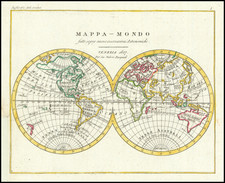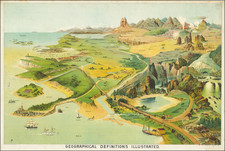World Clock, Astrological Tool, and Mountain Locator, All Rolled into One. By the Lombard Renaissance Man Ignazio Villa.
Fascinating and extremely rare 19th-century multipurpose tool focusing on predicting the future paths of the transit of Venus while also (purportedly) being a helpful geographical teaching tool.
The most obvious feature of the work are the paths it traces for the 1874, 1882, 2004, and 2012 transits of Venus, which are denoted in dashed lines. This phenomenon was of utmost importance to astronomers and explorers, as discussed below. In addition to this, the work could also be mounted as a volvelle, with the central volvelle rotated to identify the exact time, to the minute, in any part of the world. Finally, were that insufficient, the Planisfierio can be used to locate the highest mountain at any approximate longitude. This can be done simply and straightforwardly by looking at the edges of the map, finding a mountain in question, and drawing a straight line to the center of the map. This leads to the interesting superposition of the world's mountain chains in one dimension, coalescing the Andes and the Appalachians, the Atlas and the Pyrenees, and the vast Himalayas onto a single circular line.
The central projection is most uncommon to see on maps of this period. It is a type of stereographic projection centered on the South Pole, leading to a massive distortion of the northern hemisphere. This appears to be useful in showing the paths of the transits of 1882 and 1874.
This piece represents a fascinating insight into its publisher, Ignazio Villa, who named the piece after himself, as he did with many other of his creations. He was referred to by a contemporary as and "engineer, sculptor, painter, astronomer, and above all a great original." Villa is today mostly remembered for his neo-gothic architecture represented by his "Palazzio Villa" in central Florence.
We trace a reference to this work in an 1883 catalog of publications, but it is almost certain that the piece was produced prior to 1882 as it appears to refer to the 1882 eclipse in the future tense. It also appears to refer to the 1874 eclipse in the past tense. The two institutional examples are given the dates 1874 and 1879, and we find the latter more accurate.
We are aware of a second edition of this work that Villa published, also apparently pre-1882, and entitled Nuovo Planisferio Villa, this time focused on streams instead of mountains.
Importance of the Transit of Venus and Its Effects on Exploration
The transit of Venus, or the passage of Venus between the Earth and Sun, is one of the most uncommon solar phenomena that Renaissance and Enlightenment scientists were able to predict. The transit, as suggested by the dates on this chart, occurs in an unusual pattern of eight year pairs separated by a little over a century.
The phenomenon was of particular importance to astronomers who used the transit to obtain measurements for the size of the Solar System. While Kepler's Laws allowed for the relative size of orbits and speeds of the planets to be calculated, these measurements had to be provided with an absolute basis. The transit could be used in a parallax calculation if two observers stationed far enough apart on the earth's surface both recorded the transit.
The 1761 and 1769 transits were observed from locations in Saint Helena and Tahiti, in addition to Europe and North America, allowing an accurate measurement of the distance to be calculated for the first time. The Tahiti observations made by Cook in 1769 were particularly important. Cook had been sent there as part of his first voyage, jump-starting his career as one of the greatest explorers of the south seas. In 1874 and 1882, this value was further refined, including by scientists sent to Kergulen.
Rarity
We are aware of two institutional holdings of this piece, at the British Library and the Bavarian State Library. The Bavarian State Library may hold a second example, although their cataloging is unclear.










![[World -- Terrestrial Globe Gores]](https://storage.googleapis.com/raremaps/img/small/89195.jpg)

![[Pacific Ocean Centric World Map] Mappe-Monde Sur la Projection de Mercator Carte Encyprotype Dediée et Présentée à Monsieur](https://storage.googleapis.com/raremaps/img/small/69294.jpg)

